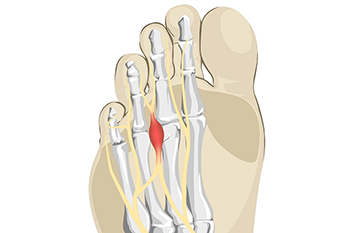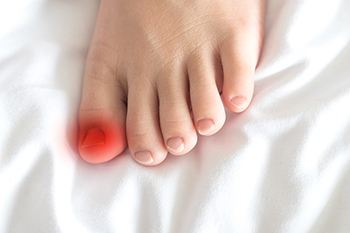Langley (604)-530-1561
Fax (778)-278-1561
Email podiatry@urton.ca
December 2023
Recognizing Common Symptoms of Morton’s Neuroma

Morton's neuroma, a nerve disorder affecting the feet, brings forth a unique set of symptoms that can disrupt daily life. Characterized by the thickening of tissues around a nerve leading to the toes, this condition commonly presents as a sharp, burning pain in the ball of the foot. Individuals with Morton's neuroma may feel as if they are standing on a pebble or a fold in their sock. This discomfort often radiates into the toes, causing tingling or numbness. The pain tends to worsen with prolonged weight-bearing activities, such as walking or standing. Wearing tight shoes exacerbates symptoms, making proper footwear selection vital for those affected. It is not uncommon for individuals with Morton's neuroma to experience a feeling of relief when they remove their shoes. If you have one or more of the above symptoms, it is suggested that you speak with a podiatrist who can accurately diagnose and treat Morton’s neuroma.
Morton’s neuroma is a very uncomfortable condition to live with. If you think you have Morton’s neuroma, contact William Urton, DPM of British Columbia. Our doctor will attend to all of your foot care needs and answer any of your related questions.
Morton’s Neuroma
Morton's neuroma is a painful foot condition that commonly affects the areas between the second and third or third and fourth toe, although other areas of the foot are also susceptible. Morton’s neuroma is caused by an inflamed nerve in the foot that is being squeezed and aggravated by surrounding bones.
What Increases the Chances of Having Morton’s Neuroma?
- Ill-fitting high heels or shoes that add pressure to the toe or foot
- Jogging, running or any sport that involves constant impact to the foot
- Flat feet, bunions, and any other foot deformities
Morton’s neuroma is a very treatable condition. Orthotics and shoe inserts can often be used to alleviate the pain on the forefront of the feet. In more severe cases, corticosteroids can also be prescribed. In order to figure out the best treatment for your neuroma, it’s recommended to seek the care of a podiatrist who can diagnose your condition and provide different treatment options.
If you have any questions, please feel free to contact our office located in Langley, BC . We offer the newest diagnostic and treatment technologies for all your foot care needs.
Risk Factors for Achilles Tendon Injuries

Achilles tendon injuries can affect anyone, but certain factors increase the likelihood of tendon problems. These factors include changes in an athlete's training schedule or intensity, shifts in playing surfaces or footwear, or having tight or weak calf muscles. Additionally, excessive pronation during walking or running, and chronic ankle instability may contribute to developing an Achilles tendon injury. An individual may be at a higher risk for these injuries from leg-length discrepancies, regular high-heel use, or intense training on hills. Increasing age, the use of specific antibiotics such as fluoroquinolones, and having high-arched feet may also lead to an Achilles tendon injury. If you have one or more of these risk factors and are experiencing recurrent pain or weakness in your heel or ankle, it is suggested that you visit a podiatrist.
Achilles tendon injuries need immediate attention to avoid future complications. If you have any concerns, contact William Urton, DPM of British Columbia. Our doctor can provide the care you need to keep you pain-free and on your feet.
What Is the Achilles Tendon?
The Achilles tendon is a tendon that connects the lower leg muscles and calf to the heel of the foot. It is the strongest tendon in the human body and is essential for making movement possible. Because this tendon is such an integral part of the body, any injuries to it can create immense difficulties and should immediately be presented to a doctor.
What Are the Symptoms of an Achilles Tendon Injury?
There are various types of injuries that can affect the Achilles tendon. The two most common injuries are Achilles tendinitis and ruptures of the tendon.
Achilles Tendinitis Symptoms
- Inflammation
- Dull to severe pain
- Increased blood flow to the tendon
- Thickening of the tendon
Rupture Symptoms
- Extreme pain and swelling in the foot
- Total immobility
Treatment and Prevention
Achilles tendon injuries are diagnosed by a thorough physical evaluation, which can include an MRI. Treatment involves rest, physical therapy, and in some cases, surgery. However, various preventative measures can be taken to avoid these injuries, such as:
- Thorough stretching of the tendon before and after exercise
- Strengthening exercises like calf raises, squats, leg curls, leg extensions, leg raises, lunges, and leg presses
If you have any questions please feel free to contact our office located in Langley, BC . We offer the newest diagnostic tools and technology to treat your foot and ankle needs.
Foot Care Practices for Distance Runners

Taking care of your feet as a runner is essential for a comfortable and injury-free experience. Start by carefully choosing your gear, especially your footwear, to prevent running injuries. Ensure a snug fit around the heel and instep to prevent friction and blisters, while leaving enough space in the toe box to accommodate downhill running and avoid bruised toenails. Choose moisture-wicking, anti-blister socks, and combine them with anti-chafe or diaper cream for lasting protection during long runs. While running, be attentive to any discomfort and take a brief pause to shake out your shoes, preventing hot spots and blisters. Consider using gaiters to shield your feet from external elements and eliminate the need for mid-run shoe cleanouts. Keep your toenails trimmed, moisturize your feet regularly, and use baby powder to keep them fresh and dry. Additionally, file down calluses to maintain a balance that prevents cracking and potential infections. Incorporate foot exercises such as the towel scrunch and resistance band calf stretch to prevent conditions like plantar fasciitis. It is suggested that you consult a podiatrist promptly if you notice any changes in your toenails or experience foot or ankle discomfort.
All runners should take extra precaution when trying to avoid injury. If you have any concerns about your feet, contact William Urton, DPM of British Columbia. Our doctor will treat your foot and ankle needs.
How to Prevent Running Injuries
There are a lot of mistakes a runner can make prior to a workout that can induce injury. A lot of athletes tend to overstretch before running, instead of saving those workouts for a post-run routine. Deep lunges and hand-to-toe hamstring pulls should be performed after a workout instead of during a warmup. Another common mistake is jumping into an intense routine before your body is physically prepared for it. You should try to ease your way into long-distance running instead of forcing yourself to rush into it.
More Tips for Preventing Injury
- Incorporate Strength Training into Workouts - This will help improve the body’s overall athleticism
- Improve and Maintain Your Flexibility – Stretching everyday will help improve overall performance
- “Warm Up” Before Running and “Cool Down” Afterward – A warm up of 5-10 minutes helps get rid of lactic acid in the muscles and prevents delayed muscle soreness
- Cross-Training is Crucial
- Wear Proper Running Shoes
- Have a Formal Gait Analysis – Poor biomechanics can easily cause injury
If you have any questions, please feel free to contact our office located in Langley, BC . We offer the newest diagnostic and treatment technologies for all your foot care needs.
What Are the Symptoms and Causes of Ingrown Toenails?

Ingrown toenails, though seemingly minor, can cause significant discomfort and warrant careful attention to both symptoms and causes. One of the primary symptoms is pain, often concentrated along the edges of the toenail, where it begins to grow into the surrounding skin. Swelling and redness may accompany the pain, indicative of inflammation and potential infection. The ingrown nail may also cause tenderness to the touch, making wearing shoes or even walking a painful experience. Causes of ingrown toenails are diverse, often stemming from improper nail trimming, wearing tight or ill-fitting footwear, or inherited structural issues such as unusually curved nails. Trauma or injury to the toe, fungal infections, and poor foot hygiene can also contribute to the development of ingrown toenails. If you have developed an ingrown toenail, it is suggested that you schedule an appointment with a podiatrist who can provide treatment options and effective preventive measures.
Ingrown toenails may initially present themselves as a minor discomfort, but they may progress into an infection in the skin without proper treatment. For more information about ingrown toenails, contact William Urton, DPM of British Columbia. Our doctor can provide the care you need to keep you pain-free and on your feet.
Ingrown Toenails
Ingrown toenails are caused when the corner or side of a toenail grows into the soft flesh surrounding it. They often result in redness, swelling, pain, and in some cases, infection. This condition typically affects the big toe and may recur if it is not treated properly.
Causes
- Improper toenail trimming
- Genetics
- Improper shoe fitting
- Injury from pedicures or nail picking
- Abnormal gait
- Poor hygiene
You are more likely to develop an ingrown toenail if you are obese, have diabetes, arthritis, or have any fungal infection in your nails. Additionally, people who have foot or toe deformities are at a higher risk of developing an ingrown toenail.
Symptoms
Some symptoms of ingrown toenails are redness, swelling, and pain. In rare cases, there may be a yellowish drainage coming from the nail.
Treatment
Ignoring an ingrown toenail can have serious complications. Infections of the nail border can progress to a deeper soft-tissue infection, which can then turn into a bone infection. You should always speak with your podiatrist if you suspect you have an ingrown toenail, especially if you have diabetes or poor circulation.
If you have any questions, please feel free to contact our office located in Langley, BC . We offer the newest diagnostic and treatment technologies for all your foot care needs.








